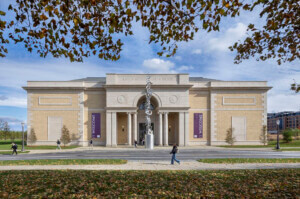Folded aluminum panels deliver the illusion of movement to passersby.
During their recent expansion, Eskenazi Hospital in Indianapolis approached Urbana Studio with an unusual request. The hospital wanted the Los Angeles-based art and architecture firm to design an interactive facade for a recently completed parking structure. “With Indianapolis’ really extreme weather patterns, we gave a lot of thought to: how can we make something that’s interactive but won’t be broken in a year?” said Urbana principal Rob Ley. “Unfortunately, the history of kinetic facades teaches us that that they can become a maintenance nightmare.” Urbana’s solution was to turn the relationship between movement and the object on its head. Though the aluminum facade, titled May September, is itself static, it appears to morph and change color as the viewer walks or drives by.
May September—a semi-transparent rectangular wall comprising 7,000 angled aluminum panels—was inspired in part by Ley’s interest in camouflage, and specifically active camouflage. “I wanted to take that on more in a passive way than an active way,” he said. The designers set out to create something like a lenticular image, which seems to shift or jump into three dimensions as the angle of view changes. “Could we make something where the pieces themselves don’t move, but we recognize that the people in front of it will be moving?” asked Ley.
Urbana Studio dedicated six months to the design before sending it to fabrication. The first half of the work was digital, primarily using Rhino and Grasshopper as well as software the designers wrote themselves in Processing. The team spent a lot of time on color. “The idea was to find two colors that would have a good contrast, and that maybe don’t exist at all in Indianapolis,” said Ley. The final scheme, which pairs deep blue with golden yellow, drew on the work of local landscape artist T.C. Steele. After building renderings and animations on the computer, the firm constructed mockups to check their assumptions.
The unique site conditions influenced both the choice of material—aluminum—and the placement of the panels. “It had to be very lightweight, because it was going on a structure that wasn’t engineered to have anything like this on it,” said Ley. The designers also had to contend with the natural movement of the garage, and wind gusts up to 90 miles per hour. “It doesn’t seem that interesting, but when the entire project is basically making sails, the wind issue is counterintuitive to what you’re doing,” said Ley.
- Fabricator Indianapolis Fabrications
- Designers Urbana Studio
- Location Indianapolis
- Date of Completion 2014
- Material aluminum flaps from Ryerson, custom aluminum extrusions from Northern States Metals, stainless steel fasteners
- Process Rhino, Grasshopper, scripting, cutting, folding, bolting, sliding, lifting, hanging
Indianapolis Fabrications fabricated and installed the facade. “We’d worked to pare the design down to be very modular, so there would be no waste materials,” said Ley. “We also worked out a system that would look like there’s an infinite number of variations of angles, but in the end there are only three. We’re faking a lot of variability with a system that doesn’t have that many possibilities.” Urbana Studio also designed a custom aluminum extrusion so that the bolts—three per panel, or 21,000 in total—could slide into the facade’s vertical structural elements without the use of a drill. “It allowed us to have this very erratic placement of elements without having thousands of holes to verify,” explained Ley. Indianapolis Fabrications assembled the facade off site in 10 by 26 foot sections. The size of the pieces was dictated by factors including the width of the street, the overhang on the existing structure, and the wind resistance each component would face as it was lifted into place.
Ley was pleasantly surprised by the interest May September generated among other would-be garage designers. “There are a lot of parking garages out there,” he said. “Usually they’re very much an appliance. As an archetype, the parking structure is not very interesting, but everyone’s anticipating that they’re not going away.” As for his own firm, Ley would welcome another commission for a parking structure—particularly one that allowed him to work from the ground up. “I enjoyed dealing with a window treatment,” he said. “But it would be nice to be involved earlier on, to be able to pursue it in a more holistic way.”










